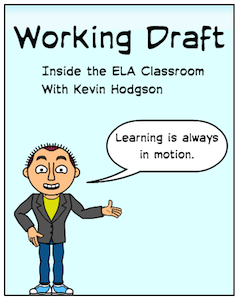Mistakes Were Made: A Classroom Confessional
A MiddleWeb Blog

We were deep into a unit I do each year with my sixth graders about the origins of the English Language, about how words arrive in such mysterious ways, and how sometimes, words get retired from the modern language, too.
A lesson on inventing new words often touches on Shakespeare and his invention of potentially hundreds of words in his plays and poems and writing. As always, I was hoping to kick the fun up a notch with technology, and I found a neat Shakespearean Insult Generator that you could embed right into a website.
Now, I’m no fool. I tried the site out a handful of times in the days before the lesson, making sure it was appropriate for my classroom. It all seemed fine. Fun, even. Rich with Shakespearean language.
The introduction in the classroom went smoothly as we moved from inventing words to a quick biographical sketch of William Shakespeare and his impact on the English Language. We shifted to our then classroom blogging site – built off Manila, a platform I no longer use and may no longer even exist – and I set my young word explorers loose with the generator.
“Uh, Mr. Hodgson?” I heard a student say, rather tentatively, after about ten minutes. “Is this … site … appropriate for school?”
Uh. Oh.
I scrambled over to look over her shoulder. I don’t remember the actual word that was sitting on her screen, but I knew it shouldn’t be there, and I knew I was the one in charge. I dashed back to my computer, in order to log into my administrative blogging account, and remove the post with the embedded insult tool. Wouldn’t you know it? The administrative site was down. Access denied. The post remained up.
“Ok, everyone,” I shouted, as I noticed a crowd around the screen of the student who had alerted me. Some were darting back to their machines. She was pointing out “that word” on her screen to the onlookers.
“We’re, ah, going to move on to something else right now. Let’s start shutting down those computers …”
Smencils and other unfortunate moments
Columnists like those of us who write in educational places like MiddleWeb often focus on the innovative practice, the things that went well enough to share out to a larger audience. We celebrate the classroom experience, from the success of our students to the intricacies of the lesson plan. We’re cheerleaders for all teachers, really. We’re just lucky enough to have a larger platform to share our work.
Let’s face it, though. Mistakes get made. Probably on a regular basis. I know this is often the case for me. Those Smencils? (“The scent lasts for two years!”) Bad idea. Smelly pencils and sixth graders don’t mix. Lesson learned. That quiz with parts of the questions and instructions completely left off the photocopy? Wish I could do that one over again. Assigning the wrong pages in the wrong book to the wrong class? That was awkward. If I wrote about all the little things that go wrong, this post would become a book.
Instead, I’m remembering some of the most memorable …
When Google slides go wrong
Two years ago, I had this grand idea for the first days of school. I would create a master Google Slideshow, and all of my students would take three of the slides in the master presentation, and work on introducing themselves. While I was not yet ready to bring them into their own Google Accounts, I figured I could make the slideshow an open and collaborative document, and provide students with the link. Easy enough. In they go.
In my head, this was both a simple assignment (take ownership of three slides and write guided by these prompts – who you are, what you did in the summer, share your favorite book). The result would be magical: a student-created, digital class book of biographical sketches on the first day of school.
Or not.
Within a few minutes of my students entering the slideshow, I quickly realized how difficult it is to have 20 people sharing a single slideshow document. Kids began moving slides around. Other slides were “taken” in tandem by multiple students, and soon I could hear students shouting out things like, Hey, you’re on my slide? and Who moved my image? and What happened to the slide I was just working on? and Help!
Yikes.
Instead of success, these reactions seemed indicative of the entire lesson – my chance at a good first impression as their new teacher was falling apart before my eyes.
I re-grouped and paused the students. I began assigning slide numbers to students, and slowly, things began to work. Sort of. The next year, I worked smarter: I brought students into their own Google accounts first, and then I had them work on their own slideshow, which I then merged into the larger digital presentation.
Glossy lost looks all round
In another case of where things went wrong, we were off the computers but still, confusion reigned.
I was introducing a lesson around vocabulary, and trying to keep the learning experience engaging, I remembered an activity a colleague who teaches English Language Learners had shown me. It’s called Mystery Words, and it involves developing “clues” to a vocabulary word – using elements like number of syllables, rhyming words, consonants and vowels, and more – so that the partner has to guess the right word, based on clues.
When my teaching colleague had done it with students in a summer program, we taught together. It was magical.
Not so with me.

They tried. They really did. But it was a near disaster. Instead of helping them remember and use vocabulary words in a different way, with a little game, I had added a level of difficulty to their work.
I think it had to do my initial clues, which were a bit too complicated for the first exposure to Mystery Words, and my overly complicated instructions. The next time (yes, I did not give up!) I was more deliberate with my clues and simplified the directions, with more sentence starters, and it all went so much smoother.
What could possibly go wrong with song lyrics
Technology, for all its wonderful possibilities, is often the source of frustration and mistakes for me. Just recently, I had what I thought was a great idea. We were reading The Watsons Go to Birmingham – 1963 by Christopher Paul Curtis, and in the book, the family installs a new record player in their car for the long drive ahead of them.
We listened to the songs in class that the narrator, Kenny, likes – “Yakity Yak” – and the song that mom likes – “Under the Boardwalk” – and we talked about how each song represents each character’s traits, in many ways.
In a burst of misguided inspiration, I created a lesson in Google Slides in which students would find and choose songs to represent the other characters in the Watsons’ story, using the video search function within Google Slides to make a “character playlist.” I even added a slide at the end, asking each student to find a song that would represent them on a long journey.

I sort of let that project fade away, although to be frank, the conversations about how music might be part of the way to think of a literary character was interesting, and the students did enjoy being able to merge video and music into our analysis work.
Their behavior vs. mine
I think one the biggest mistakes I make, too often, is to react to a student’s behavior without always knowing their full story – being aware of all of the emotional baggage that comes to school with them every day. Sometimes, I know some of their stories. Sometimes, not enough. Sometime, I go home at night wondering how I might have done that differently or approached this student from another angle, or just had found another way forward.
More than once, if I’ve come realize my mistake in handling a matter, usually in the middle of the night, I’ve pulled a student aside the next morning, apologized for the way I reacted to a situation, and tried to find some common ground for us to move forward into the new day ahead of us both.
Most times, they forgive me, and I forgive them, and that spark of honest talk begins a new understanding. Sometimes, that trust even lasts. We can all learn from our mistakes. That’s part of teaching, too.


































Kevin, your reflection shows the art of teaching– moving forward with students, being prepared and at the same time learning with students, as well as being able to on-the-spot adapt lessons for the best [and sometimes more appropriate] fit for the students in our classroom. Your last example is key: great teachers look first at their own actions to see their effect on students. Thanks for your wisdom and willingness to share the errors that we all experience. ~ Sheri
Thanks, Sheri. Reflective practice …
I thoroughly enjoyed reading this post and want to thank you for writing and sharing it. As most, if not all, teachers, I can identify very well with these situations and was smiling a wry smile as I read, my mind darting off to a memory of some similar situation of my own.
There is a constant tension between the ‘venting’ or ‘letting off steam’ (at the extreme, the ‘moaning’) teachers and the ‘positive attitude’, ‘we can do this’ (at its extreme, the ‘irritatingly preppy’) teachers in the community. I wish that we would share more often tales of the good, bad and ugly in our classrooms – I feel it would take away some of the pressure that leads to the moans and increase the feeling of support that would allow more positivity. TL;DR More, please!
Julia
Thank you for the comment, and I agree. We need it all, if only to make better sense of the reality of teaching practices.
Kevin